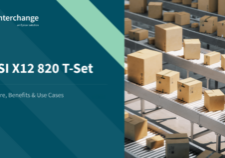How Much Does EDI Cost?
Modern EDI has evolved to offer more formats and standards, as well as API integration and other powerful B2B integration features. Around 59% to 85% of businesses use EDI today, and surveys show that demand among smaller businesses is spurring growth and development in EDI software.1
As businesses look to add EDI to their tech stacks or move from a in-house integration system to a modernised alternative, there are understandable concerns around how much it costs to implement.
In today’s blog, we’re going to delve into the:
- Benefits of EDI.
- Types of EDI solutions available.
- Costs of implementing EDI.
In order to make the right choice, businesses need to understand EDI cost and the ROI of different EDI implementations. This blog will tell you everything you need to know to make that choice and set your business on the right track for the future.
Suggested reading: Check out our eBook to learn more about how to become a supply chain-centred business.
What is EDI and why is it important?
The origin of electronic data interchange (EDI) is largely credited to Army Master Sergeant Ed Guilbert, who developed standardised shipping mandates for the US army.2 The concept of standardisation remains central to modern EDI – the goal is to unite businesses under common standards and formats so they can engage in frictionless trade.
Globalisation spurred the growth and development of EDI, which was endorsed by the World Bank in the mid-90s prior to the development of the Pan European Public Procurement Online (PEPPOL) standard.3
EDI facilitates the digital exchange of key B2B documents, from customs documents to invoices (e.g. EDI 810).
Almost any business sending and receiving goods can use EDI, but the technology is adept at organising complex goods flows between large-scale manufacturers, suppliers and retailers. EDI is frequently used in the following industries:
The benefits of EDI
EDI has evolved to leverage new technologies such as API integration, cloud computing, AI and automation. In addition, value-added EDI networks (VANs) have made it much simpler to access cutting-edge EDI tools without costly in-house installations.
The benefits of EDI include:
- Increased speed and efficiency: EDI accelerates B2B communication and data exchange. This can increase business cycle speed by some 61%.4
- Improved accuracy: EDI involves computer-to-computer communication that avoids manual handling errors and human oversight. Improvements in accuracy and efficiency are the most important EDI benefits, according to one study.5
- Cost savings: By improving speed, efficiency and accuracy, EDI effectively cuts costs across the spectrum of warehousing to logistics and delivery. For example, EDI unlocks new potential for just-in-time (JIT) logistics and enhances EDI logistics workflows, which is shown to reduce warehouse costs and avoid overcapacity.6
- Return on investment: With the above benefits considered, EDI provides an excellent return on investment and enables businesses to compete globally.
Types of EDI
EDI has evolved to keep up with new technologies and business demands. EDI pricing, therefore, varies with the exact business requirements and EDI capabilities required.
At the simpler end of the spectrum, a business might use EDI to exchange standard documents in a range of formats to remove paper processes. At the more complex end of the spectrum, a business might need to:
- Map EDI documents between standards.
- Connect EDI to an ERP.
- Integrate first- and third-party APIs.
Suggested reading: Check out our blog to learn more about how APIs are affecting EDI.
Below, we’re going to look at the specific types of EDI solutions currently available to businesses:
On-premise EDI
On-premise EDI exists on-site, e.g. at head office or a dedicated logistics department.
Here, the EDI software is installed and operated from an in-house server, and can be connected to an ERP system to exchange EDI transactions and other relevant data.
The benefits of on-premise EDI
- Accountability: In-house systems aren’t dependent on third parties. They’re manageable on-site by those with the required experience.
- Control: By maintaining in-house EDI, businesses maintain control of their own systems and can add, remove or upgrade hardware as and when required.
- It just works: Many mature businesses have been maintaining on-site infrastructure for decades, and it just works. Dismantling a system that fulfils its job may not always be worth it.
- Bespoke solutions: EDI-mature businesses can cater to complex business needs and may have the internal expertise to develop solutions to new problems quicker than if they were relying on a third party.
Costs of on-premise EDI
- Expensive to maintain: Many in-house setups are now considered legacy systems which are costly to maintain. Tech Target identifies staff costs, environmental costs, maintenance costs, technical debt and opportunity costs as some of the drawbacks of legacy IT.7
- Hardware costs: Purchasing the hardware required to run on-premises systems involves considerable up-front costs. Adding software capabilities may mean adding new servers, databases and other hardware. If the system is swapped to a cloud or SaaS alternative, that equipment becomes redundant.
- EDI software licences: Buying an on-premises licence is often more expensive than paying a rolling fee for a cloud-based or managed service.
Still unsure? Here’s our take on delivering automotive manufacturing supply chain success.
Cloud-based EDI
Cloud-based alternatives have gradually replaced on-premises solutions. 70% of businesses now rely on cloud-based business apps, forecast to rise to 85% by 2025.
Cloud-based EDI consists of web-based, off-premise tools that enable businesses to send, receive and manage EDI data without their own hardware. This is necessary for businesses that don’t yet have fixed premises, such as remote businesses, many small and medium-sized businesses, and startups.
Value-added networks (VANs) and Web EDI have come to define the modern B2B data interchange industry.
Benefits of cloud-based EDI
- Ease of use: EDI was formerly a convoluted, niche software class that wasn’t exactly intuitive to use. Modern web EDI is much simpler and makes B2B integrations easy for those with little or no prior experience. This also accelerates onboarding, thus speeding up the process of connecting to new partners.
- Scalable: Since there’s no need for on-site infrastructure, a VAN system is easier to scale because resources and integrations are delivered by a provider. New features, such as API integrations, are added by the provider, and businesses don’t need to engineer their own solutions.
- Near-100% uptime: Cloud-based EDI providers deliver their services via cutting-edge technology with near-100% uptime. Off-site data solutions may be more secure than on-site, and many providers offer ISO certification to this effect.
- Cutting-edge technology: Providers are always upgrading their cloud-based EDI to offer new features and solutions. As EDI experts, providers offer training and support to customers to ensure they’re getting the most out of their software.
Costs of cloud-based EDI
- Dependence: When they use cloud-based EDI, businesses rely on the third party to deliver critical services. For the most part, however, the third party will provide superior uptime to most on-premises setups.
- Data and support services: SaaS and web EDI is scalable, but costs can escalate as businesses add more features.
- Lack of customisation: Mature businesses may require a level of customisation that cloud-based EDI can’t deliver. However, the right provider will work with businesses to provide bespoke solutions that cater to their unique needs.
Managed service EDI
Managed EDI, or EDI-as-a-service, places all EDI responsibility into the hands of the provider. The provider owns the maintenance of the EDI system, including trading partner management, data integration, and implementation.
This enables businesses to take advantage of cutting-edge EDI without in-house hardware or skills.
Benefits of managed service EDI
- Active support: Managed services provide active EDI support, ensuring new partners are onboarded quickly and professionally. EDI experts directly support businesses to drive efficiency.
- Reduced costs: While outsourcing EDI might seem an expensive option, you’ve got to factor in cost reductions in on-site hardware, in-house expertise, maintenance and downtime. Managed services mean the provider’s team takes care of EDI infrastructure, simplifying costs, operations and connectivity.
- Cutting-edge solutions: Managed EDI enables businesses to leverage next-gen tools and expertise to accelerate business cycles and advertise their credentials to prospective partners. The cost of investing in cutting-edge on-site infrastructure and skills is significantly higher than outsourcing.
- Customisable: Managed services simplify the process of customising EDI to businesses and their unique supply chains. By placing EDI responsibilities into the hands of the managed service provider, businesses can focus on growth.
Costs of managed service EDI
- Third-party management: By outsourcing all EDI responsibilities and infrastructure to a third party, you can maximise ROI and guarantee you get the expertise you need. It’s also far more efficient, saving you the costs and effort of recruiting an in-house team.
- Dependence: Similarly to cloud-based EDI, outsourcing business-critical functions involves a bond of trust. The provider is responsible for uptime and functionality, hence why choosing the right provider is paramount.
Find a cost-effective solution for your business
No matter the type of EDI, choosing the right provider is paramount. Cloud-based and EDI managed services offer many benefits over traditional on-premises, and their drawbacks are mitigated by choosing providers with exceptional EDI expertise.
Data Interchange’s managed EDI service combines deep technical expertise with business support and training. Our future-proof EDI offers our class-leading VAN, DiNet, and cutting-edge solutions such as API integrations. This will ensure your ROI is maximised, no matter the EDI implementations.
Managed EDI from Data Interchange offers:
- In-house cost savings: Our fully managed service delivers cutting-edge talent and state-of-the-art infrastructure, cutting costs compared to internal hiring and investing in expensive on-site hardware.
- Access to the best EDI tools and talent: Getting the most out of EDI integration and tools can be challenging. Data Interchange’s EDI-as-a-service service grants the benefits of cutting-edge to businesses.
- Reduced disruption and downtime: By leveraging Data Interchange’s advanced infrastructure, businesses can be assured of near-zero downtime and excellent data security, courtesy of our ISO 27001 certification.
Talk to an expert today to learn more about the specific costs of EDI, and how Data Interchange can help turbocharge your B2B data exchange.
2 Without EDI, Industry Would Not Be Where It Is Today | AIMagazine
3 https://peppol.eu/what-is-peppol/
4 Benefits of EDI | EDI Basics
6 Just-in-Time (JIT): Definition, Example, and Pros & Cons | Investopedia
7 What is the hidden cost of maintaining legacy systems? | Tech Target





























































































































